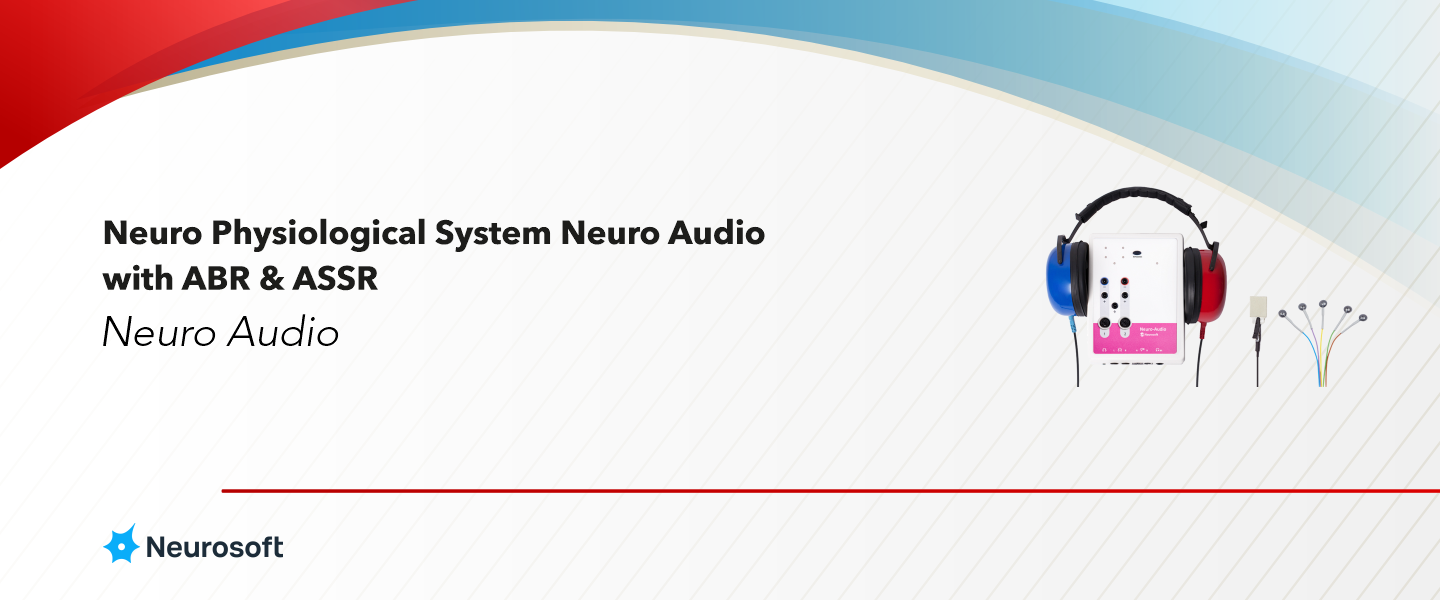

Neuro-Audio BERA is designed specifically for ABR testing and combines years of amplifier design and manufacturing experience to provide a flexible system. The recording is made with 1 or 2 channels for air or bone conduction.
Well-considered system characteristics (low level of amplifier noise) and software features (adaptive notch filter, weighted averaging, statistical measures of signal and noise, up-to-date algorithms for automatic response detection) help a device user to obtain a high-quality record quickly. All tests can be performed when patient is awake (non-sedated).
Chirp stimulus is a new stimulus that allows to obtain the response of higher amplitude compared to traditional stimuli. Chirp stimulus takes into account the cochlear anatomy and uses different time shift for different frequencies. Thus, the low frequencies reach the cochlea before the high frequencies. But in the cochlea itself the high-frequency receptors are located prior to the low-frequency receptors. Due to such stimulus waveform, hair cell responses along the whole length of the cochlea (or in one octave range) occur at the same time (synchronized). This leads to the increase of combined neural response that comes to the auditory nerve.
Neuro-Audio BERA delivery set includes TDH-39 headphones, the most popular headphones model for BERA testing in the world .
We can optionally supply Ear Tone 3A insert earphones, B-71 bone vibrator (which is applied to estimate air-bone gap to determine type of hearing loss), sound field speakers, TDH-39 acoustically shielded headphones, HDA-280 headphones.
Modern interface, powerful database, configurable, normative data, high quality of recording and reproducible results allow a specialist to solve a wide range of daily audiological problems with highest accuracy. A battery of pre-defined test templates and features streamline the workflow and productivity. Neuro-Audio/ABR can be used both in clinics and research facilities.
|
|
|
|
|
|
|
|
|
: | 2 |
|
: | 20 μV to 50 mV |
|
: |
|
: | 0.1 to 400 μV | |
|
: | ± 15 % |
|
: | ± 10 % |
|
: | ± 5 % |
|
: | not more than 0.5 μV |
|
: | 200 Hz – 80 kHz |
|
: | not less than 90 MΩ |
|
: | 0.01–5000 Hz |
|
: | 10–10000 Hz |
|
: | not less than 40 dB |
|
: | not less than 100 dB |
|
: | 21-20832 |
|
||
|
Auditory Stimulator: |
|||||
|
|
: | 144 dB SPL (at 3 kHz frequency) | ||
|
|
: | -10 dB HL (or less) | ||
|
: | 137 dB SPL |
|
: | 0.1–100 Hz with the admissible relative deviation of ± 0.1 % |
|
: |
|
: | ||
|
: | with ±3.0 dB accuracy |
|
: | 20–10000 Hz |
|
: | with ±5.0 dB accuracy |
|
: | 0.05–50 ms |
|
: |
|
: | pure tone | |
|
: | 50–5000 μs with the admissible relative deviation of ± 2 % |
|
: | amplitude, frequency, amplitude and frequency modulation |
|
: | condensation, rarefaction, alternating |
|
: | 125-8000 Hz |
|
: | White noise (0.02–10000 Hz) |
|
: | 20-200 Hz |
|
: |
|
: | ||
|
: | 2.5% |
|
: | 10-10000 Hz |
|
: | 5.5% |
|
: | 499 Hz, 1 kHz, 2 kHz, 4 kHz |
|
: | 2 |
|
: | 0–127 dB SPL (stimulus relative) |
|
: | yes |
|
: | 0 |
|
: | -10 – 80 dB HL (at 3 kHz frequency) |
|
: | (19.5 ± 0.5) dB |
|
General Parameters and Specifications: |
|||||
|
: | USB |
|
: | |
|
: |
|
: | from +5ºC up to +40ºC | |
|
: | from - 50ºC up to +50ºC |
|
: | 30%–85% |
|
: | 20%–95ºC |
|
: | 70–106 kPa |
|
: | from 70 kPa | |||
|
: | 1 |
|
: | 1 |
|
: | 1 |
|
: | 5 |
|
: | 1 |
|
: | 1 |
|
: | 1 |
|
: | 1 |
|
: | 1 |
|
: | 1 |
|
: | 1 |
|
: | 1 |
|
: | 100 |
|
: | 1 |
|
: | 1 |
|
: | 1 |
|
: | 1 |
|
: | 1 |
|
: | 1 |
|
: | 1 |
|
: | 1 | |||
|
Aksesoris Lokal: |
|||||
|
: | 1 |
|
: | 1 |
|
: | 1 |
|
: | 1 |